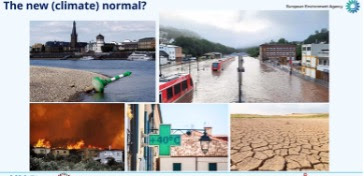A Digitális Föld Nemzetközi Társaság (ISDE) elnöke Dr. Alessandro Annoni, a JRC egykori részlegvezetője (hozzá tartozott az INSPIRE és az alapadatok, majd a Digitális Föld és Digitális Gazdaság témaköre) október 25-én azzal keresett meg ISDE alapító tagokat, köztük Tim Foresman (Egy.Áll.) , Mario Hernandez (Mexikó) , Milan Konecny (Csehország), John van Genderen (Hollandia), Richard Simpson (Ausztrália), Hiromichi Fukui (Japán) professzorokat, hogy osszák meg gondolataikat a készülő és hamarosan publikálandó Digital Earth Vision 2030 dokumentum kapcsán, annak tartalmi ismerete nélkül a digitális föld jövőjéről, hogy a szerzői munkaközösség még figyelembe vehesse a felkértek releváns, befolyás-mentes meglátásait. Annoni levélre adott hozzájárulásomra az ISDE elnöke november 9-i válaszában azt írta, meglátom majd, a legtöbb felvetésemet a hamarosan publikált dokumentum tartalmazni fogja. Megküldött gondolataim a következők voltak:
"Not yet being familiar with the draft text, and the recent email conversation and inputs, here you are my prompt thoughts related to the ISDE Vision 2030.
According to my view in general,
the new Vision 2030 should reflect ISDE’s scientifically sound, innovative, and practical approach using the digital technologies - a digital twin based on EO, GI, multidomain/multilayered Big Data, AI etc. - to model and simulate the Earth System.
Well documented and preserved geo-located, multitemporal observation data, as well as any type of associated facts and evidence are crucial to provide analysis ready data, as input for modelling and simulation, to generate reliable information needed by evidence-based decision making.
The aim should be to support strengthening the resilience of the human societies and their citizen to adopt to the challenges caused by impacts of the critical changes (e.g., draught, floods, food and water security, societal security, migration, human settlements, energy crisis, disaster risk reduction, economic shortage, transportation, and supply chain discrepancies - only a few to mention)
Based on the efforts and achievements reached by ISDE so far, and taking into account the urgent need of acceleration of the accomplishment of the Agenda 2030 SDGs, five major areas seem to be especially adequate, beneficial and feasible where ISDE could act and contribute:
1. Promote innovative contribution to the achievement of some selected SDGs. Preference should be given to interdisciplinary approach, where interoperability, compliance with standards and readiness for cooperation and common interest of the participants/partners are inevitable. Potential areas include Food-Water-Energy or Urban climate-Health-Energy Nexus. Besides Universities and Academia, engagement of industry stakeholders and empower citizens are critical to attract governments too.
2. Promote capacity building/education related to the multiscale Digital Earth model from local to global providing insight of the capabilities for the benefit of the societies. Education, raising motivation in this context is recommended from the elementary school, mobilizing the pupils and students by competition and interactive gaming plus advocating relevant curriculum.
3. By networking - the science/academia and private sector leadership, to facilitate coordinated collaboration in selected SDGs being capable to provide information and/or services as support of decisions related to early warning, warning, and emergency warning (based on present but not limited on SDG targets and indicators). Such a contribution might be attractive for the governments from local to national level and for the intergovernmental custodian organization as well.
4. Communication of these efforts and achievement, providing platform for exchange of relevant information. The involvement of volunteers, citizen scientists and the learned societies/NGOs to be welcomed. Providing publication (e.g., in IJDE, JBED, Nature, NPAS) for disseminate innovative, sustainable, and resilient solutions, best practices, lessons learned in any of the 17 SDGs areas would be significant contribution and enhance the cohesion in the ISDE network (to be further develop on regional and national level as well)
5. To keep/strengthen horizontal relations, partnerships with global stakeholders such as ISC, UN[1], GEO, CEOS, OGC and institutions such as JRC, IIASA, IISD and CBAS to facilitate the accomplishment of 1-4, by the way raise visibility and to allow wider acknowledgement, while the priority of points 1-5 are subject of and depends on the ISDE governance.
The UN Water Conference (Spring, 2023)[2] would be an excellent occasion to announce the enhanced ISDE Vision for 2030
Gabor Remetey
6. 11. 2022"
[1] UN: here, potential partners include the FAO, UN Statistical Division, UNSD GGIM, UNEP, UNESCO, UN HABITAT (with its New Urban Agenda), WHO, WMO, UNDP and SDSN as well as UN supported/acknowledged regional offices (from Geneva to Beijing)
[2] (Extract from official UN news: a Preparatory Meeting took place on 25 October 2022, at UN HQ in New York. Immediately prior to the Preparatory Meeting, approximately 1,200 stakeholders participated in the Stakeholder Dialogue of the Preparatory Meeting for the UN 2023 Water Conference. This one-day event was organized to ensure that stakeholders would have meaningful input to the Preparatory Meeting. It took place online and in person at UN Headquarters on 24 October 2022. Discussions focused on the catalyzers of the SDG6 Global Acceleration Framework. UN General Assembly President Csaba Kőrösi encouraged participants to discuss “game changers” from the perspective of “solidarity, sustainability, and science,” which is the motto of the 77th session of the UNGA.)





